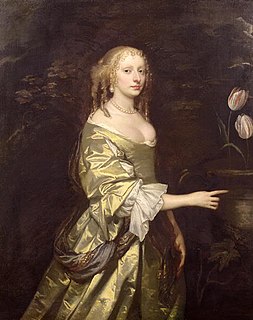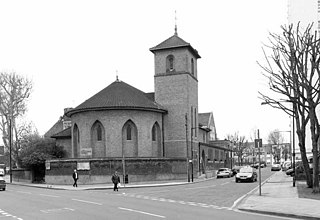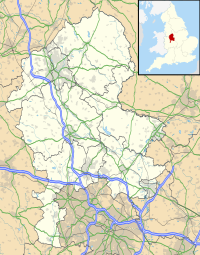
Sir George Gilbert Scott, known as Sir Gilbert Scott, was a prolific English Gothic revival architect, chiefly associated with the design, building and renovation of churches and cathedrals, although he started his career as a leading designer of workhouses. Over 800 buildings were designed or altered by him.

Lichfield Cathedral in Lichfield, Staffordshire, England, is the only medieval English cathedral with three spires. The Anglican Diocese of Lichfield covers Staffordshire, much of Shropshire, and parts of the Black Country and West Midlands. The current Bishop of Lichfield, Michael Ipgrave, was appointed in 2016. It is a Grade I listed building.

Spelsbury is a village and civil parish about 1.5 miles (2.4 km) north of Charlbury and about 4 miles (6.4 km) southeast of Chipping Norton, Oxfordshire. The village is on a narrow hill between the Coldron and Taston brooks overlooking the River Evenlode and the ancient Wychwood Forest to the south. Spelsbury parish includes the hamlets of Dean and Taston, and also includes Ditchley Park. The 2011 Census recorded the parish's population as 305.

Sir Arthur William Blomfield was an English architect. He became president of the Architectural Association in 1861; a Fellow of the Royal Institute of British Architects in 1867 and vice-president of the RIBA in 1886. He was educated at Trinity College, Cambridge, where he read Architecture.

Weston Park is a country house in Weston-under-Lizard, Staffordshire, England, set in more than 1,000 acres (400 ha) of park landscaped by Capability Brown. The park is located 10 miles (16 km) north-west of Wolverhampton, and 8 miles (13 km) north-east of Telford, close to the border with Shropshire. The 17th-century Hall is a Grade I listed building and several other features of the estate, such as the Orangery and the Stable block, are separately listed as Grade II.

Weston-under-Lizard is a village in the South Staffordshire district of Staffordshire, England. It constitutes a civil parish with Blymhill, called Blymhill and Weston-under-Lizard. It is known as Weston-under-Lizard to distinguish it from Weston-on-Trent. It should not be confused with the village of Weston, to the north east of Stafford.

Ewan Christian (1814–95) was a British architect. He is most notable for the restorations of Southwell Minster and Carlisle Cathedral, and the design of the National Portrait Gallery. He was Architect to the Ecclesiastical Commissioners from 1851 to 1895. Christian was elected A RIBA in 1840, FRIBA in 1850, RIBA President 1884–86 and was awarded the Royal Gold Medal in 1887.

Sir Charles Archibald Nicholson, 2nd Baronet, was an English architect and designer who specialised in ecclesiastical buildings and war memorials. He carried out the refurbishments of several cathedrals, the design and build of over a dozen new churches, and the restoration of many existing, medieval parish churches.
Sir William Wilson was an English architect, builder and sculptor.

The medieval cathedrals of England, which date from between approximately 1040 and 1540, are a group of twenty-six buildings that constitute a major aspect of the country’s artistic heritage and are among the most significant material symbols of Christianity. Though diverse in style, they are united by a common function. As cathedrals, each of these buildings serves as central church for an administrative region and houses the throne of a bishop. Each cathedral also serves as a regional centre and a focus of regional pride and affection.

Ingestre is a village and civil parish in the Stafford district, in the county of Staffordshire, England. The population of the civil parish taken at the 2011 census was 194. It is four miles to the north-east of the county town of Stafford.

St Chad's Church is in the village of Hopwas, Staffordshire, England. It is an active Anglican parish church in the deanery of Tamworth, the archdeaconry of Lichfield and the diocese of Lichfield. Its benefice is combined with those of St Editha, Tamworth, St Francis, Leyfields, and St Andrew, Kettlebrook. The church is recorded in the National Heritage List for England as a designated Grade II listed building.
The baronetcy of Wilbraham of Woodhey, Cheshire, was created by James I on 5 May 1621 in the Baronetcy of England for Richard Wilbraham. He was a descendant of the ancient Cheshire family of Radnor who acquired Woodhey by marriage in the 14th century.

St Bartholomew's Church is in Penn, a district of Wolverhampton, West Midlands, England. It is an active Anglican parish church in the deanery of Trysull, the archdeaconry of Walsall, and the diocese of Lichfield. Its benefice is united with that of St Anne, Lower Penn. The church is recorded in the National Heritage List for England as a designated Grade II* listed building.

Elizabeth, Lady Wilbraham, née Mytton, was a member of the English aristocracy, who traditionally has been identified as an important architectural patron.

Staffordshire is a county in the West Midlands region of England. In 1974 the historical county of Staffordshire was combined with the unitary authority of Stoke-on-Trent to form the ceremonial county of Staffordshire.

All Hallows, Bow, is an Anglican church in Bow, London, England. It is within the Diocese of London.

St Edward the Confessor's Church is an active Anglican church in Leek, Staffordshire, England. The building, which dates back to the 13th century, is listed Grade II*.
Blymhill and Weston-under-Lizard is a civil parish in the district of South Staffordshire, Staffordshire, England. It contains 61 listed buildings that are recorded in the National Heritage List for England. Of these, five are listed at Grade I, the highest of the three grades, and the others are at Grade II, the lowest grade. The parish contains the villages of Blymhill, Weston-under-Lizard, Brineton, Great Chatwell, and Orslow, and the surrounding countryside. Much of the parish is occupied by the country house Weston Hall and its estate, Weston Park. The house and many structures within the estate are listed. Most of the other listed buildings are houses, cottages, farmhouses and farm buildings, the earlier of which are timber framed or have timber famed cores. The other listed buildings include churches, memorials in the churchyards, and a public house

















